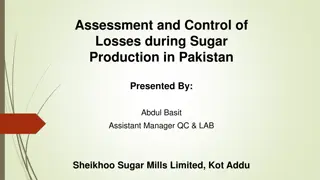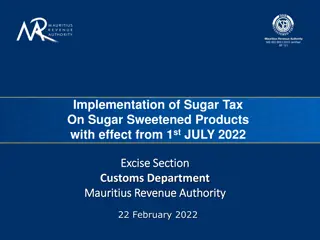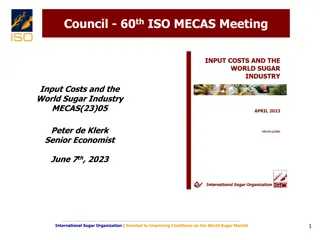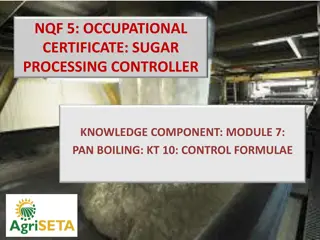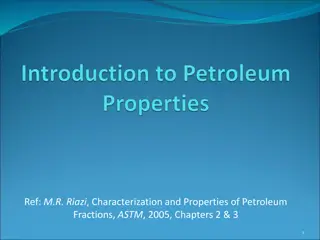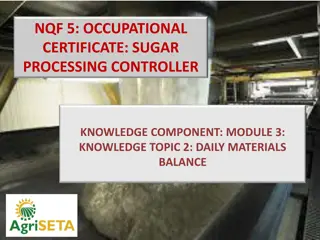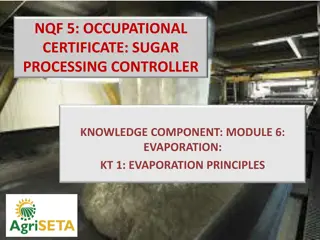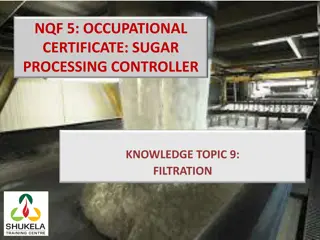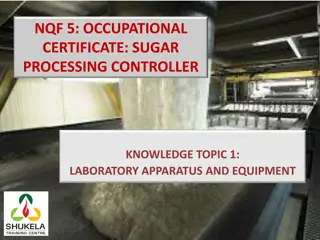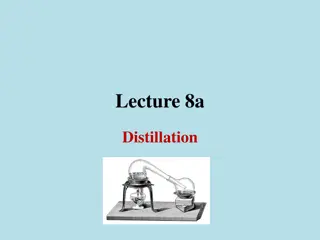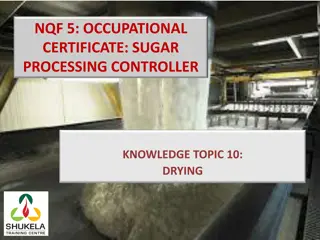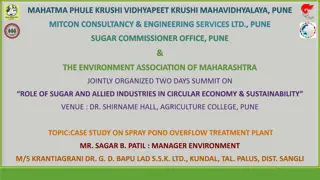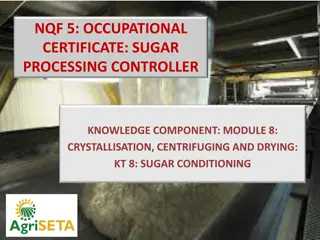Understanding Continuous Pan Boiling in Sugar Processing
Continuous pan boiling is a key process in sugar production, involving multiple compartments where massecuite is heated and circulated. This method ensures efficient crystallization and control of brix levels for optimal sugar quality. The design, operation, and control of continuous pans play a vital role in maintaining the desired purity and consistency of the final sugar product.
Download Presentation

Please find below an Image/Link to download the presentation.
The content on the website is provided AS IS for your information and personal use only. It may not be sold, licensed, or shared on other websites without obtaining consent from the author. Download presentation by click this link. If you encounter any issues during the download, it is possible that the publisher has removed the file from their server.
E N D
Presentation Transcript
NQF 5: OCCUPATIONAL CERTIFICATE: SUGAR PROCESSING CONTROLLER KNOWLEDGE COMPONENT: MODULE 7: PAN BOILING: KT 9: CONTINUOUS PAN BOILING
Continuous pan design and basic operation Continuous pans are divided into a number of cells/compartments (usually 12) that are separated from each other. The massecuite in each compartment is heated by steam fed to a calandria. The large calandria stretches throughout the pan.
Continuous pan design and basic operation (cont.)
Continuous pan design and basic operation (cont.) Seed massecuite is pumped into the first compartment of the continuous pan. The massecuite overflows from one compartment to the next via a weir. The flow of massecuite is driven by the flow of seed massecuite into the first compartment. Each compartment has a feed system to supply molasses (syrup in the case of a continuous A-pan), water or steam. As the massecuite flows towards the last compartment, crystals grow on the sucrose supplied in the feed.
Continuous pan design and basic operation (cont.) At any point in time the massecuite in the different compartments is at different stages in its change from seed to fully developed massecuite at the discharge end. As the massecuite progresses each subsequent compartment is set at a higher brix to maintain the massecuite in the metastable zone. The brix in each compartment is usually measured using a conductivity probe and is automatically controlled by varying the feed to that compartment.
Continuous pan design and basic operation (cont.) The following table and graph shows the brix profile for the different compartments of a continuous C-vacuum pan as measured by conductivity probes. Control compartments 1 2 3 4 5 6 7 Brix of massecuite 90.9 91.3 92 93 94 95 96 Conductivity set point 59 58 53 48 44 40 22
Continuous pan design and basic operation (cont.) The low conductivity in the last cell is due to the brixing up that is necessary before discharging the massecuite to crystallisers. In this case every second compartment is monitored for control purposes. The brix curve above is based on a massecuite purity of 53%. If the purity decreases the brixes of each cell must be increased to maintain optimum boiling conditions and vice versa.
Pan Control Once a day, samples of the massecuite in the different control compartments are taken and sent to the laboratory for brix analysis. The results are plotted and compared with the target values. If the brix of a particular cell is too low (i.e. the massecuite is slack ), the conductivity set point of that cell is reduced so that the brix will increase. If the brix of a particular cell is too high (i.e. the massecuite is too tight ), the conductivity set point of that cell is increased so that the brix will reduce.
Pan Control (cont.) Each cell is also regularly checked for its feel (slack/tight) and for the presence of false grain. If false grain has formed in a cell, the brix of the preceding cell is reduced by increasing its conductivity set point. The crystal content of all cells must also be checked periodically. The crystal content must be kept between 30 - 33%. If the crystal content is low, the rate that seed massecuite is fed to the first compartment must be increased and vice versa.
Pan Control (cont.) The seed for a continuous pan is grown in a pan which is a batch pan using graining with slurry. A continuous pan is continuously fed with seed into its first compartment.
Pan Control (cont.) An A-continuous pan is fed with B-magma. Since this seed contains some small crystals; the feed is washed in the first few compartments by adding water to dissolve these small crystals. A major difference between batch and continuous pans is the difference in hydrostatic head of the massecuite. In a continuous pan the hydrostatic is small and remains constant. The difference in temperature between the top and bottom of the massecuite is thus small.







